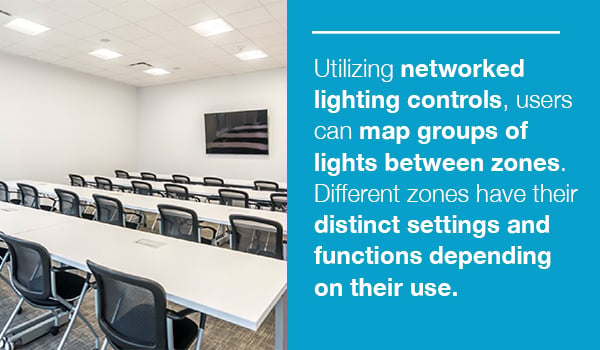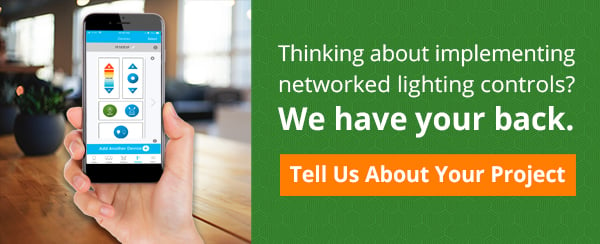
As connected technology becomes more sophisticated, it is becoming increasingly important for building owners and facility managers to leverage that same technology for operational efficiencies. Advanced lighting controls, also known as networked lighting controls, offer the opportunity to gain cost savings through lighting design strategies. In a world driven by efficiency, networked lighting controls have advantages over conventional options to optimize building performance while promoting occupant well-being.
1. Motion Detection
One of the more fundamental lighting control features, motion detection became more prevalent as LEDs grew into the standard technology for lighting. Active sensors use microwave pulses and other methods to detect changes in the area they cover. Passive infrared sensors detect changes in body heat (infrared energy) emitted by all warm-blooded creatures. Once installed, motion detection allows lights to dim down when spaces are not occupied and get brighter when people are present.
2. Daylight Harvesting
Photocells, also known as daylight sensors, have infrared light shining permanently on a light-dependent resistor that produces a steady electric current. When it gets darker, light stops reaching the resistor. When the resistance changes, it suddenly creates much less current. The circuit then detects that change in current and triggers an action, like making a light brighter.
The daylight harvesting feature takes advantage of available natural light in an interior space through windows using photocell sensors to adjust the lighting. That means it can automatically dim lights closest to windows while still maintaining the required light levels in a room. The daylight harvesting control feature can save energy while still providing the right amount of light for specific tasks or situations.

3. Dynamic Tunable Lighting
Tunable white lighting technology gives the end-user the ability to adjust the correlated color temperature (CCT) to provide fully warm to fully cool lighting (and everything in between). Levels are dynamic to mimic the various colors of daylight from sunup to sundown. Not only does tunable white lighting offer aesthetic choices for a room, but it also plays a critical role in supporting the human circadian system.
4. Circadian Rhythm Control
Lighting plays an essential role in setting and regulating the body’s biological clock. Your body naturally knows when to wake up and when to go to sleep. At all times of the day, your body is supposed to have a natural rhythm that guides alertness, sleeping, and eating patterns.
Research studies show that light intensity, timing, and spectral content influence the hormones in your body. Hormones, like Melatonin, can affect mood, attentiveness, and overall health. By utilizing Circadian Rhythm control, an end-user can change light color and intensity to regain healthy habits or treat health conditions like sleeping disorders.

5. Individual and Group Lighting Settings
With networked lighting controls, lights may be controlled individually or in groups. End-users can program them to operate automatically via sensors and respond to manual switches or smartphones. An advantage of grouping lights together is that if one light’s motion sensor is activated, all other lights in the same group respond in unison. They can also be programmed with specific time delays, CCT, dimming levels, and take advantage of calendar functions.
6. Create Scenes or Map Zones
Similar to programming groups, scenes are groups of lights programmed for specific applications or tasks. Consider the conditions for meeting rooms where presentations happen and the lights that need to be dim in those areas. Once scenes are programmed, lighting can be adjusted easily by the touch of a button. Utilizing networked lighting controls, users can map groups of lights between zones. Different zones have their distinct settings and functions depending on their use. For example, a school may have classrooms, corridors, gyms, and offices divided into Zones. Office buildings may have each floor divided into open areas, perimeter offices, meeting rooms, and reception areas.

Take Advantage of Networked Lighting Controls With Smart Blu 2.0
LED lighting networked with controls can help build smart buildings that reduce energy consumption while creating environments focused on occupant well-being. When considering implementing controls with your next lighting project, it is crucial to think about how your facility operates and what capabilities it needs.
Are you looking to capitalize on all these features in one inclusive platform? Smart Blu 2.0 is a wireless Bluetooth light control system that utilizes Bluetooth Mesh and eliminates the need for LAN or internet. Smart Blu enables significant power and maintenance savings for LED lighting through simple automation processes while allowing for individual freedom to adjust as necessary.
Want to learn more about lighting controls? Read more about how LED lighting and networked lighting controls play a pivotal part in education and healthcare facilities. You can also check out this infographic to learn about the evolution of lighting controls.










